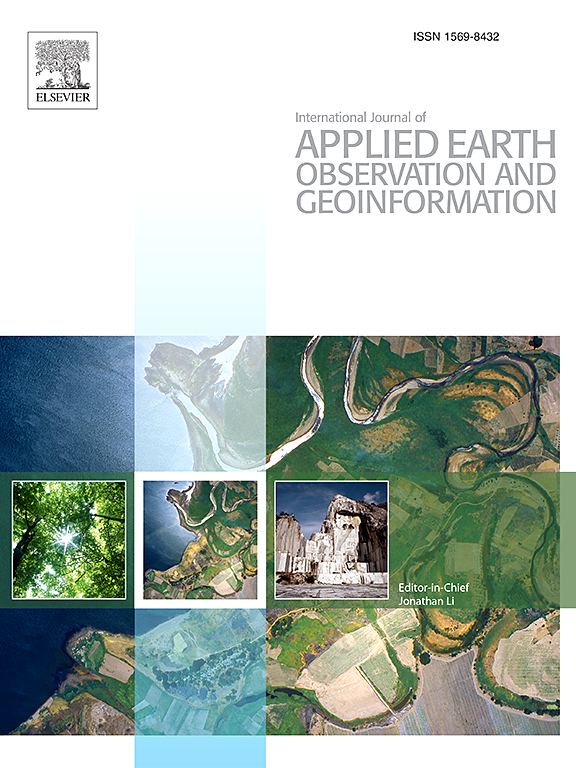Automatic crop type mapping based on crop-wise indicative features
IF 7.6
Q1 REMOTE SENSING
International journal of applied earth observation and geoinformation : ITC journal
Pub Date : 2025-04-27
DOI:10.1016/j.jag.2025.104554
引用次数: 0
Abstract
Mapping crop types with remote sensing imagery is crucial for timely acquisition of crop planting information. However, large-scale crop type mapping is often hindered by the absence of ground truth data and spatiotemporal heterogeneity of available cloud-free optical images. In this study, the conception of daily crop-wise indicative features (DCIF) was proposed for automatic crop mapping to address this issue. Crop-wise indicative feature (CIF) was defined as a comprehensive feature that can distinctly differentiates the target crop and all other classes, with the CIF value showing a polarization trend with target crop close to 1 and others close to 0. Logistic Regression (LR) model was utilized to learn CIF of target crop on each single date, referred to as CIF extractor. The time series analysis method (i.e., seasonal trend decomposition) and imputation method was then utilized for the discrete time series of CIF extractors, which were separately trained based on training samples on each day. This process yielded the DCIF extractor that can capture the unique feature pattern on any given day during the entire growing period. The comprehensive features produced by DCIF extractor later served as the input of Otsu algorithm to automatic distinguish target crop from other crops. Our results in Heilongjiang, China, Iowa, USA, and Bas-Rhin, France show that the DCIF extractor effectively overcomes abovementioned challenges in crop mapping by applying time series analysis method at model-level. The overall accuracy exceeded 90 % in Heilongjiang and Iowa for both 2021 and 2022. In Bas-Rhin, where fragmented land parcels and uneven crop distribution are prevalent, the overall accuracy surpassed 87 %. The proposed method provides a scientific basis for crop acreage estimation and field management, contributing to more informed agricultural practices.
基于作物指示性特征的自动作物类型映射
利用遥感影像绘制作物类型是及时获取作物种植信息的关键。然而,由于缺乏地面真实数据和可用的无云光学图像的时空异质性,大尺度作物类型制图常常受到阻碍。为了解决这一问题,本研究提出了每日作物指示特征(DCIF)的概念,用于自动作物制图。作物指示特征(CIF)定义为一种能够明显区分目标作物与其他所有类别的综合特征,CIF值呈现出目标作物接近于1而其他作物接近于0的极化趋势。利用Logistic回归(LR)模型学习目标作物在每个单一日期的CIF,称为CIF提取器。然后对CIF提取器的离散时间序列采用时间序列分析方法(即季节趋势分解)和归算方法,分别基于每天的训练样本对CIF提取器进行训练。这个过程产生了DCIF提取器,它可以在整个生长期的任何一天捕获唯一的特征模式。DCIF提取器产生的综合特征作为Otsu算法的输入,实现目标作物与其他作物的自动区分。我们在中国黑龙江、美国爱荷华州和法国下莱茵省的研究结果表明,DCIF提取器通过在模型层面上应用时间序列分析方法,有效地克服了作物作图中的上述挑战。在黑龙江和爱荷华州,2021年和2022年的总体准确率都超过了90%。在下莱茵省,土地分散,作物分布不均匀,总体精度超过87%。该方法为作物种植面积估算和田间管理提供了科学依据,有助于提高农业实践的知识性。
本文章由计算机程序翻译,如有差异,请以英文原文为准。
求助全文
约1分钟内获得全文
求助全文
来源期刊

International journal of applied earth observation and geoinformation : ITC journal
Global and Planetary Change, Management, Monitoring, Policy and Law, Earth-Surface Processes, Computers in Earth Sciences
CiteScore
12.00
自引率
0.00%
发文量
0
审稿时长
77 days
期刊介绍:
The International Journal of Applied Earth Observation and Geoinformation publishes original papers that utilize earth observation data for natural resource and environmental inventory and management. These data primarily originate from remote sensing platforms, including satellites and aircraft, supplemented by surface and subsurface measurements. Addressing natural resources such as forests, agricultural land, soils, and water, as well as environmental concerns like biodiversity, land degradation, and hazards, the journal explores conceptual and data-driven approaches. It covers geoinformation themes like capturing, databasing, visualization, interpretation, data quality, and spatial uncertainty.
 求助内容:
求助内容: 应助结果提醒方式:
应助结果提醒方式:


